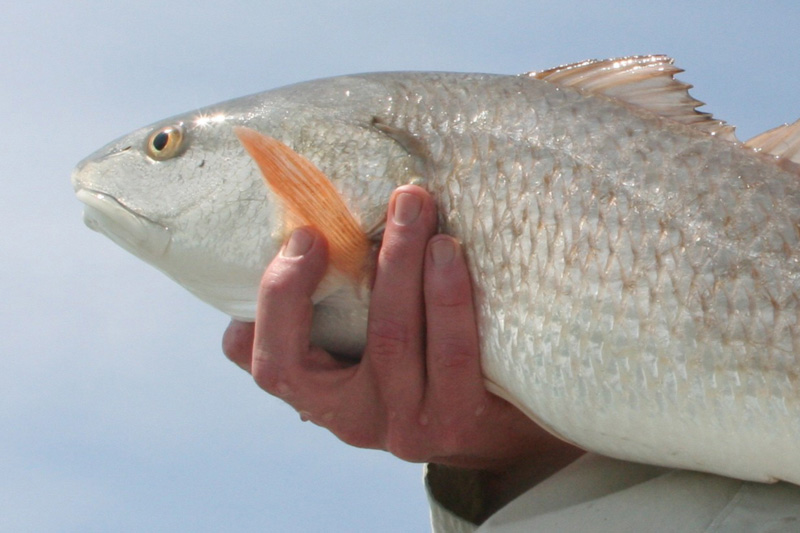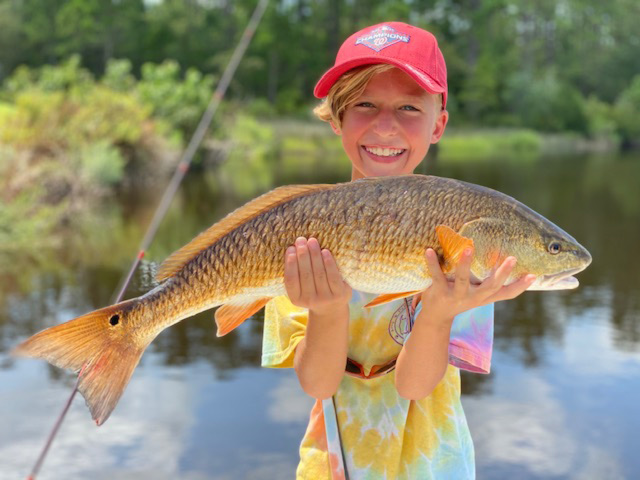As August hits many Chesapeake Bay catch-and-release anglers will begin targeting big bull redfish in the Middle Bay, and as summer turns into fall, Lower Bay anglers of a similar attitude will enjoy their run from these very same fish. But from now clear through Christmas, both will also likely spend some time searching for slot fish — puppy drum between 18 and 26 inches in Virginia and between 18 and 27 inches in Maryland — that can go in the cooler and then onto the grill.

Finding Puppy Drum
Puppy drum do get caught by anglers fishing in deep waters, but for the most part, targeting slot drum is a shallow-water game. Points with current rips, rip-rap, underwater rocks, creek mouths, and oyster bars are all prime suspects. As a general rule of thumb, waters from one to six or eight feet deep are ideal.
Top well-known western shore redfish hotspots in Virginia waters include the oyster bar edges and the Lesner Bridge areas in Lynnhaven, marsh edges in Rudee, points and cuts in the lower Poquoson River, grassbeds and oyster bars in Mobjack Bay, and grassbeds, oyster bars, and creek mouths in the Piankatank and around Gwynn Island. Most years they make it up to the Rap as well, but this far north is less reliable from season to season as compared to points south. On the ESVA, any of the cuts and creek mouths from Cape Charles clear up into the Pocomoke Sound can hold pups but as general rule getting inside the larger creeks and looking for points hit by current and/or feeder creeks with moving tidal water is a better bet than fishing open waters. Another good bet is fishing the grass beds and stumps near the islands in the Sound.

TIP: When you’re fishing grass beds working the edges can be good, but can also be time-consuming. When fishing is slow, focusing your efforts only where you find variations in the grasses, such as the underwater points they form, pot-holes, and breaks between beds, is generally more productive.
Historically speaking, Maryland’s waters are certainly less reliable for puppy drum than those of Virginia. While Virginian anglers might consider catching five or six pups in an outing good fishing, and a dozen fish an awesome day, those numbers should be halved or even quartered to keep expectations realistic north of the state line. And remember, some seasons very few redfish will get north of the Rappahannock. But in recent years this fishery has certainly been on the up-swing, and some seasons an oddball or two will even pop up as far north as the Bay Bridge. On the west side, the St. Mary’s River and lower portions of the Pax are top bets when the fish do roam up this way. For several years running they’ve also made a decent showing at the Calvert Cliffs power plant discharge late in the fall. Across on the eastern side of the Bay the Tangier Sound is the undisputed champ, with island points where visible current rips form being top prospects, followed by weed beds and stump fields.
Tip: When casting to a visible current rip, try aiming up-current of the rip itself and allow the moving water to take your offering into the strike zone as it sinks. Often the reds will hit when it’s close to the bottom, so if you cast right into the middle of the rip, sometimes it will get swept beyond the fish before they ever have a chance to spot it.
The Best Lures for Slot Redfish
Puppy drum can be targeted with either bait or lures, with some regional and/or situational variations. In the lure department four- to six-inch soft plastics are very popular, usually in white, chartreuse, or root-beer in stained waters. Many folks swear by Gulp! Jerk Shad and Swimming Mullet. Unlike targeting stripers, few redfish sharpies add a skirt to their jigs.

Hard baits are less popular among dedicated drummers but some folks, mostly in the Bay’s southern areas, do like to employ MirrOlures and similar suspending twitchbaits. Occasionally topwater will get the job done, too, but for the most part only during periods of ambient light. Another offering that works particularly well around rip-rap and in other scenarios where you’re casting right up to a shoreline is spinnerbaits, usually with gold or copper-colored blades. In fact, it’s not unusual for perch anglers tossing Perch Ponders and similar small spinnerbaits to feel the unexpected jolt of a redfish attack.
Tip: In cloudy or off-colored water, dark spinnerbaits sometimes out-fish anything else by a wide margin.
Bait is also a great way to target reds, with a caveat. Peanut bunker, finger mullet, and shrimp (live if you can get ‘em) are all very effective when fished on fishfinder rigs. However, in many areas there will be too many crabs and/or small bait-stealers around to fish bottom. In that case, employing a float or popping cork rig set so the bait’s kept just off bottom gets the job done.
Tip: Whenever you plan to fish cut bait, bringing a cast net along is a good idea — having something alive and kicking on the hook almost always trumps anything that’s dead.
Go With the (Tidal) Flow
One stand-out feature that seems to attract the pups like no other is a draining inlet. Areas where marsh flats or tidal ponds drain to deeper waters during a falling tide are often topnotch. When you find this sort of feature try fishing it from high water until low tide, to determine what stage of the tidal cycle they cruise out of the shallows and head for deeper waters. Once you ID the timing of the fish’s appearance in a draining inlet on the tidal cycle in a particular spot, you can often nail down a repeatable pattern.
Okay: are you psyched to go on the prowl for puppies? We certainly hope so, because this fishery has only been getting better and better in the Chesapeake recently. The best bite will come during the fall months, but you can start honing your skills right now. And with a little luck, you’ll soon be firing up that grill.